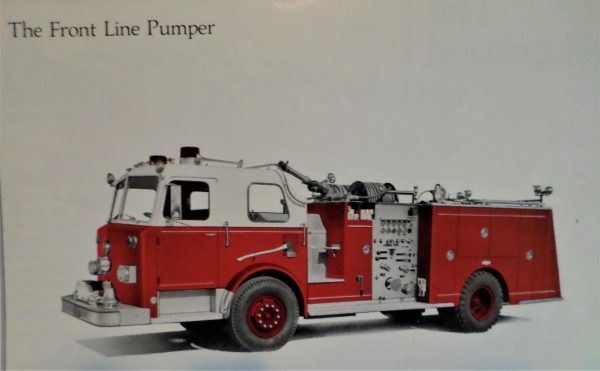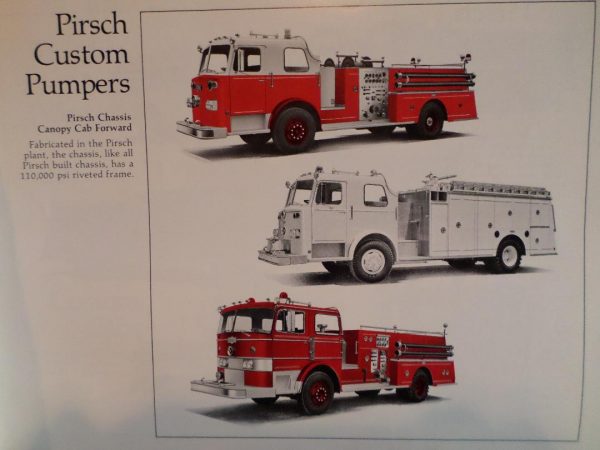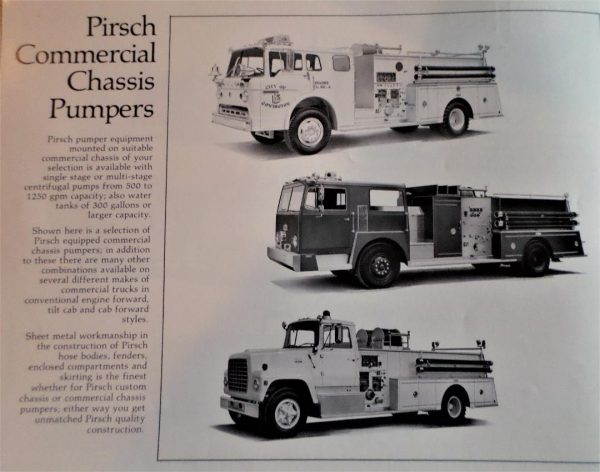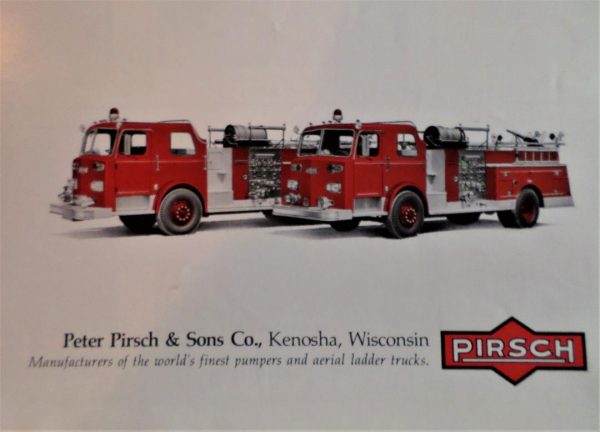This from Mike Summa for #TBT:
For TBT- Pirsch fire trucks were a big part of the American fire service. Many city and suburban fire departments utilized this type of apparatus. Many years ago I mailed a letter to Pirsch asking for literature. These are a sample of what was sent.Mike Summa























































Pingback: Fire service history … Peter Pirsch & Sons (more) « chicagoareafire.com
#1 by Austin on November 23, 2019 - 6:58 PM
Thanks Crabby and Drew for the info, much appreciated.
#2 by CrabbyMilton on November 22, 2019 - 3:05 PM
I need to make a correction so I don’t mislead here. The MFD 1988 PIRSCH custom was a pumper that served E6 and later E24. It was the only one so they had so perhaps it was a demo or someone else’s cancellation.
#3 by Tim on November 22, 2019 - 1:47 PM
Don’t forget Truck 46 had a Mack Pirsch LOL!!!!
#4 by Bill Post on November 22, 2019 - 1:27 PM
Chuck the remounted ladder that went to Truck 24 came off of Truck 16’s 1968 Mack CF rearmount. The Ford chassis was a 1978 model with rear canopy style crew cab by 3D. It’s funny that Truck 24 is still in the same single truck house that was recommended to be replaced years ago.
There is a good chance that they might be relocated into Engine 115’s new house when it opens (hopefully next year) but even that needs to be confirmed. I’ve heard more than one rumor as to what will be done with Truck 24 and their current station.
#5 by Bill Post on November 22, 2019 - 1:07 PM
There is no question that Milwaukee was a Pirsch town especially when it came to aerial ladders. A number of Chicago’s suburbs such as Skokie and Evanston had fleets that were predominantly Pirsch and the same went for Memphis.
Chicago apparently liked Pirsch ladders. One of the last jobs the CFD ordered from Pirsch was to remount four mid-mounted, 1966 100-foot ladders which came off of Mack C-Model chassis. They became rear mounted ladders on new 1988 Ford chassis. So while Chicago didn’t have many Pirsch metal aerials, they certainly got their money’s worth from the ones they had and then some.
Chicago also purchased six rear-mounted 100-foot Pirsch ladders on Mack CF chassis. Three in 1968 and the others in 1972. Those were assigned to busy companies that had a lot of working fires. Truck 15 and Truck 22 had the 1968 models and four years later they were reassigned the 1972 units. Their 1968 rigs became hand-me-downs assigned to other busy companies. It’s a shame that Chicago didn’t order more them as they were among the few rigs on Mack CF chassis.
#6 by Chuck on November 22, 2019 - 12:35 PM
Bat10, you are correct. That rig was new when I entered the Academy in July of 1988 as a paramedic. It was supposedly refused by its original department (or that was at least the story I had heard at the time.) And Milton, the 1988 you mentioned at Truck 24 was actually an ’82 or ’83 remount on a Ford chassis with bodywork by 3D Metals of a ’60s Pirsch ladder from Truck 16 (?) – the original rig was wrecked in an accident.
#7 by Drew Smith on November 22, 2019 - 12:32 PM
In 1982, Brookline MA Firefighter Joseph Tynan fell from a responding Peter Pirsch Company fire engine. Tynan suffered massive brain damage from the accident. The Pirsch Company was found liable in 1986 for the accident, and was successfully sued for $5 million. Tynan had been in the standing position of the 1976 engine with an open jump seat. Although there were apparently doors added to the jump seat area, the classic Pirsch grab rail that spanned the trailing edge of the cab roof and its sides was a point made by the plaintiff. It is widely believed that the defense of this lawsuit and $5M judgement played a role in Pirsch’s demise. This lawsuit was a major factor in the development of NFPA 1500 and its first adoption in 1987 when fully-enclosed cabs were made a requirement.
Lawsuits
https://www.firefighterclosecalls.com/firefighter-death-under-investigation/
https://www.firehouse.com/apparatus/news/12297117/lawyer-neil-rossman-on-joe-tynans-apparatus-death-firefighter-news
Pirsch history
http://www.coachbuilt.com/bui/p/pirsch/pirsch.htm
https://en.wikipedia.org/wiki/Peter_Pirsch_and_Sons
Pirsch aerials
https://www.patersonfirehistory.com/peter-pirsch-aerials.html
#8 by CrabbyMilton on November 22, 2019 - 11:56 AM
The bottom line is because they let their quality and internal practices go down the toilet. When you do that, do not be surprised if your customers look elsewhere if you jerk them around enough.
#9 by Austin on November 22, 2019 - 11:25 AM
So why did PIRSCH fold anyway? I don’t really see anything online saying why they stopped making apparatus.
#10 by Bat10 on November 22, 2019 - 10:47 AM
Did the last Pirsch rearmount end up at the CFD academy for training around 1988?
#11 by Matt on November 22, 2019 - 7:30 AM
I am sure it is not just coincidence. They were a custom builder and the presentation of an array of vehicles with different configurations showed what they could do. I have factory literature from Pirsch where the FD name was left on the vehicles, especially from the 1950’s. Good customers tended to be featured often.
#12 by John on November 21, 2019 - 8:43 PM
Pirsch was also a major player in Northeast Ohio.At one point,Akron was about 95% Pirsch.Then when I moved to central Illinois,Bloomington still had a couple of ’em,and Champaign was mostly Pirsch at the time.
#13 by John Antkowski on November 21, 2019 - 5:34 PM
Tom Conrad, Great to hear from you!! I didn’t know you followed this website. I love this website and the variety of information it supplies. I enjoy the Chicago link but Information from the whole state is cool too. And sometimes interesting information surfaces about Milwaukee and the MFD. Take care. John.
#14 by Joe Smith on November 21, 2019 - 4:49 PM
Pirsch dominated the apparatus market in the Chicago-Milwaukee area and was also popular in other areas including Boston, DC, Memphis, and Atlanta. I toured the factory in the early 1980’s and was fascinated by the craftsmanship involved in producing the custom cab, which was hand formed on a wooden pattern. There was a 1930’s aerial trailer in the shop being rebuilt. The industry was undergoing change, and Pirsch disappeared along with several other long established manufacturers within a period of a few years.
#15 by MABAS 21 on November 21, 2019 - 4:47 PM
The pic of the first pumper with the squad body is very similar to Villa Park’s Engines 964 and 965.
The second pic with the white pumper squad is very similar to Wood Dale’s Engine 16.
Wonder if these were generic examples of those.
#16 by B Murphy on November 21, 2019 - 4:01 PM
Rich- the difference is zilch. Same thing, different name. Pump, water booster tank, hose, a few ladders and assorted and various tools and nowadays EMS gear. Primary function is to ‘get the wet stuff on the red stuff.’ Most FDs call them Engines, a few use the term Pumpers, as well as Pump or Wagon. It’s all just a matter of local tradition.
#17 by CrabbyMilton on November 21, 2019 - 2:55 PM
They also had that 1988 ? PIRSCH built on perhaps a DUPLEX. It served at 24 at one point.
#18 by Tom Conrad on November 21, 2019 - 2:18 PM
John
Back in the days when I was still in the fire alarm office and we had the first version of the CAD yes it could not understand 2 engines in one house so in the computer world Engine 20 was a single house. However us older school dispatchers always knew the difference if we were the ones doing the sending of companies. In fact we used to joke about the line in the concrete floor (as engine 2 and engine 20 were parked side by side in the firehouse) being the dividing line. Gone are those days. Now everyone seems to just use the CAD.
On the apparatus side, Pirsch was a staple back in the day. Many truck companies easily from the 50’s through 80’s. I grew up with many of the MAck CF/Pirsch rearmounts. In addition to the Hendrickson chassis. MFD had a number of Ford L with Pirsch bodies.
Tom
#19 by John Antkowski on November 21, 2019 - 1:33 PM
Milwaukee also had a pair of those Pirsch Hendrickson’s like the one in the above photo. The downtown station known as “The House of Glass” had 2 Engine companies, Engine 2 and Engine 20. They were always assigned identical rigs. Engine 20 was disbanded in 2006 due to budget constraints. What was interesting about that firehouse was that in the early days Engine 20 was assigned to a phantom location because the cad system back than didn’t recognize that there were 2 engines in one house with different still districts. John
#20 by CrabbyMilton on November 21, 2019 - 12:37 PM
Grand old long defunct builder. MFD only had 2 custom (1963) chassis cab forward pumpers like that but many conventional PIRSCH apparatus.
#21 by Rich Kane on November 21, 2019 - 11:00 AM
What is the difference between a pumper and an engine?